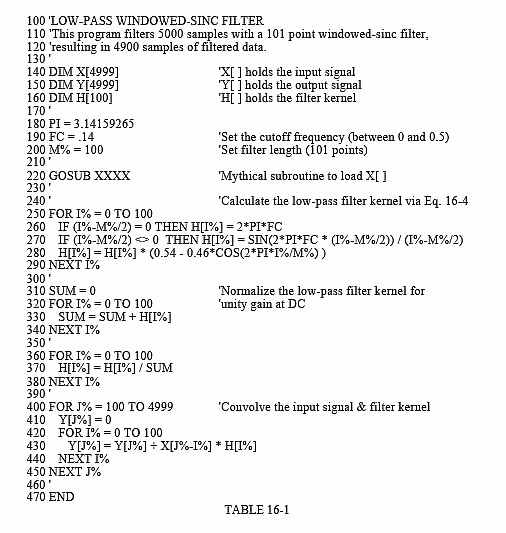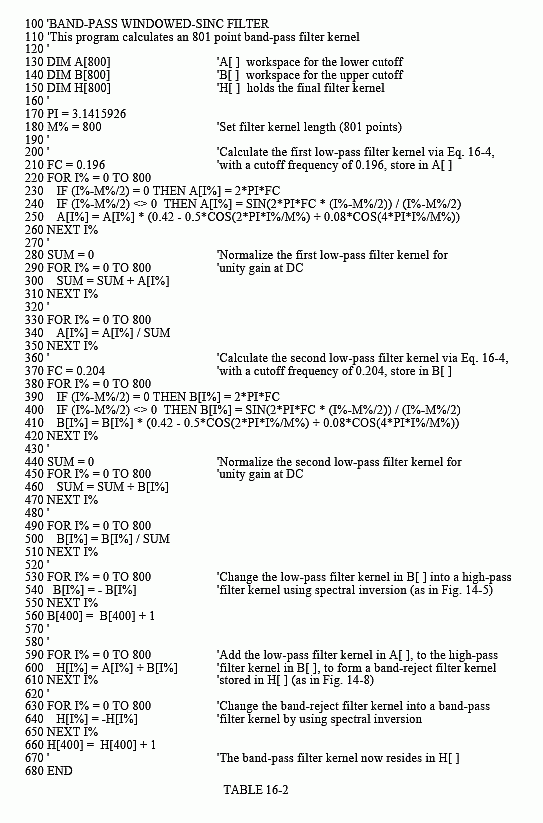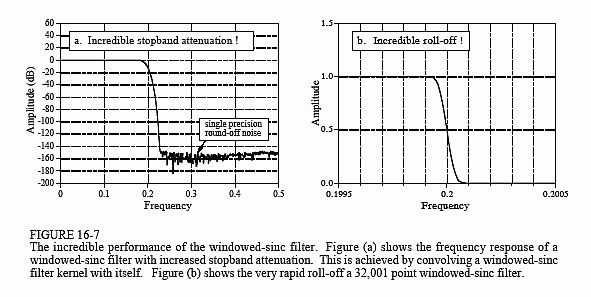The Scientist and Engineer's Guide to
Digital Signal Processing
By Steven W. Smith, Ph.D.
Book Search
Table of contents
- 1: The Breadth and Depth of DSP
- 2: Statistics, Probability and Noise
- 3: ADC and DAC
- 4: DSP Software
- 5: Linear Systems
- 6: Convolution
- 7: Properties of Convolution
- 8: The Discrete Fourier Transform
- 9: Applications of the DFT
- 10: Fourier Transform Properties
- 11: Fourier Transform Pairs
- 12: The Fast Fourier Transform
- 13: Continuous Signal Processing
- 14: Introduction to Digital Filters
- 15: Moving Average Filters
- 16: Windowed-Sinc Filters
- 17: Custom Filters
- 18: FFT Convolution
- 19: Recursive Filters
- 20: Chebyshev Filters
- 21: Filter Comparison
- 22: Audio Processing
- 23: Image Formation & Display
- 24: Linear Image Processing
- 25: Special Imaging Techniques
- 26: Neural Networks (and more!)
- 27: Data Compression
- 28: Digital Signal Processors
- 29: Getting Started with DSPs
- 30: Complex Numbers
- 31: The Complex Fourier Transform
- 32: The Laplace Transform
- 33: The z-Transform
- 34: Explaining Benford's Law
How to order your own hardcover copy
Wouldn't you rather have a bound book instead of 640 loose pages?Your laser printer will thank you!
Order from Amazon.com.
Chapter 16: Windowed-Sinc Filters
The windowed-sinc filter can be pushed to incredible performance levels without nasty surprises. For instance, suppose you need to isolate a 1 millivolt signal riding on a 120 volt power line. The low-pass filter will need

a stopband attenuation of at least -120dB (one part in one-million for those that refuse to learn decibels). As previously shown, the Blackman window only provides -74dB (one part in five-thousand). Fortunately, greater stopband attenuation is easy to obtain. The input signal can be filtered using a conventional windowed-sinc filter kernel, providing an intermediate signal. The intermediate signal can then be passed through the filter a second time, further increasing the stopband attenuation to -148dB (1 part in 30 million, wow!). It is also possible to combine the two stages into a single filter. The kernel of the combined filter is equal to the convolution of the filter kernels of the two stages. This also means that convolving any filter kernel with itself results in a filter kernel with a much improved stopband attenuation. The price you pay is a longer filter kernel and a slower roll-off. Figure 16-7a shows the frequency response of a 201 point low-pass filter, formed by convolving a 101 point Blackman windowed-sinc with itself. Amazing performance! (If you really need more than -100dB of stopband attenuation, you should use double precision. Single precision


round-off noise on signals in the passband can erratically appear in the stopband with amplitudes in the -100dB to -120dB range).
Figure 16-7b shows another example of the windowed-sinc's incredible performance: a low-pass filter with 32,001 points in the kernel. The frequency response appears as expected, with a roll-off of 0.000125 of the sampling rate. How good is this filter? Try building an analog electronic filter that passes signals from DC to 1000 hertz with less than a 0.02% variation, and blocks all frequencies above 1001 hertz with less than 0.02% residue. Now that's a filter! If you really want to be impressed, remember that both the filters in Fig. 16-7 use single precision. Using double precision allows these performance levels to be extended by a million times.
The strongest limitation of the windowed-sinc filter is the execution time; it can be unacceptably long if there are many points in the filter kernel and standard convolution is used. A high-speed algorithm for this filter (FFT convolution) is presented in Chapter 18. Recursive filters (Chapter 19) also provide good frequency separation and are a reasonable alternative to the windowed-sinc filter.
Is the windowed-sinc the optimal filter kernel for separating frequencies? No, filter kernels resulting from more sophisticated techniques can be better. But beware! Before you jump into this very mathematical field, you should consider exactly what you hope to gain. The windowed-sinc will provide any level of performance that you could possibly need. What the advanced filter design methods may provide is a slightly shorter filter kernel for a given level of performance. This, in turn, may mean a slightly faster execution speed. Be warned that you may get little return for the effort expended.
